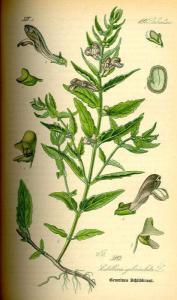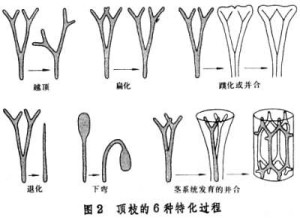顶枝学说
概述
 用以阐明维管植物的叶、孢子叶以至种子植物花部的起源和演化的理论.德国学者齐默尔曼于1930年提出.后来又经过多年的补充丰富和发展.该学说主要依据化石蕨类植物莱尼蕨的形态特征,认为最原始的陆生植物是由中干和两叉分枝的顶枝系统组成的,无叶,无真根,有的顶枝生有孢子囊,称为能育顶枝,有的顶枝不产生孢子囊,称为不育顶枝.以后由莱尼蕨这种类型的顶枝系统的进一步发展,经过“耸出”(越顶)、扁化、网化(蹼化)、退化和下弯5个基本过程或其中的某些过程的不同结合,演化出维管植物主轴上的叶子(小型叶、大型叶)、孢子叶以及种子植物生殖结构.如由顶枝束经过“耸出”、扁化、网化的过程演化出大型叶;由顶枝系统经耸出、扁化、退化过程演化出小型叶等.这一学说普遍受到学者们的重视与支持,当然它还需要不断地丰富、完善和发展.To clarify the vascular plants, leaves, spores of seed plants as well as floral leaves the origin and evolution theory. German scholar Zimmerman made in 1930. Later, after many years of additional enriched and developed. The doctrine based primarily on fossil fern Lenny fern plants of the morphological characteristics, that the most primitive land plants powered by dry and two fork branching system consisting of the top branches, no leaves, no true roots, some of the top branches birth sporangium, saying that In order to education the top branches, some of the top branches does not produce sporangia, called the top branches of infertility. after this type of fern by Lenny, the top branches of the further development of the system, after "out-Song" (the more the top), flat-based , network-based (webbed-oriented), degradation, and the next bend, or five basic processes, some of which passes through the different combination of vascular plants evolved spindle leaves (small leaves, large leaves), spores leaf and seed plant reproductive structures . such as the beam from the top sticks after "out-Song", flat-based, network-based process evolved a large leaf; from the top sticks out of the system by-Song, flat-based, small-scale degradation processes, evolved leaf. This doctrine generally scholars attention and support, of course, it needs to continue to enrich, improve and develop.
用以阐明维管植物的叶、孢子叶以至种子植物花部的起源和演化的理论.德国学者齐默尔曼于1930年提出.后来又经过多年的补充丰富和发展.该学说主要依据化石蕨类植物莱尼蕨的形态特征,认为最原始的陆生植物是由中干和两叉分枝的顶枝系统组成的,无叶,无真根,有的顶枝生有孢子囊,称为能育顶枝,有的顶枝不产生孢子囊,称为不育顶枝.以后由莱尼蕨这种类型的顶枝系统的进一步发展,经过“耸出”(越顶)、扁化、网化(蹼化)、退化和下弯5个基本过程或其中的某些过程的不同结合,演化出维管植物主轴上的叶子(小型叶、大型叶)、孢子叶以及种子植物生殖结构.如由顶枝束经过“耸出”、扁化、网化的过程演化出大型叶;由顶枝系统经耸出、扁化、退化过程演化出小型叶等.这一学说普遍受到学者们的重视与支持,当然它还需要不断地丰富、完善和发展.To clarify the vascular plants, leaves, spores of seed plants as well as floral leaves the origin and evolution theory. German scholar Zimmerman made in 1930. Later, after many years of additional enriched and developed. The doctrine based primarily on fossil fern Lenny fern plants of the morphological characteristics, that the most primitive land plants powered by dry and two fork branching system consisting of the top branches, no leaves, no true roots, some of the top branches birth sporangium, saying that In order to education the top branches, some of the top branches does not produce sporangia, called the top branches of infertility. after this type of fern by Lenny, the top branches of the further development of the system, after "out-Song" (the more the top), flat-based , network-based (webbed-oriented), degradation, and the next bend, or five basic processes, some of which passes through the different combination of vascular plants evolved spindle leaves (small leaves, large leaves), spores leaf and seed plant reproductive structures . such as the beam from the top sticks after "out-Song", flat-based, network-based process evolved a large leaf; from the top sticks out of the system by-Song, flat-based, small-scale degradation processes, evolved leaf. This doctrine generally scholars attention and support, of course, it needs to continue to enrich, improve and develop. 附件列表
词条内容仅供参考,如果您需要解决具体问题
(尤其在法律、医学等领域),建议您咨询相关领域专业人士。

